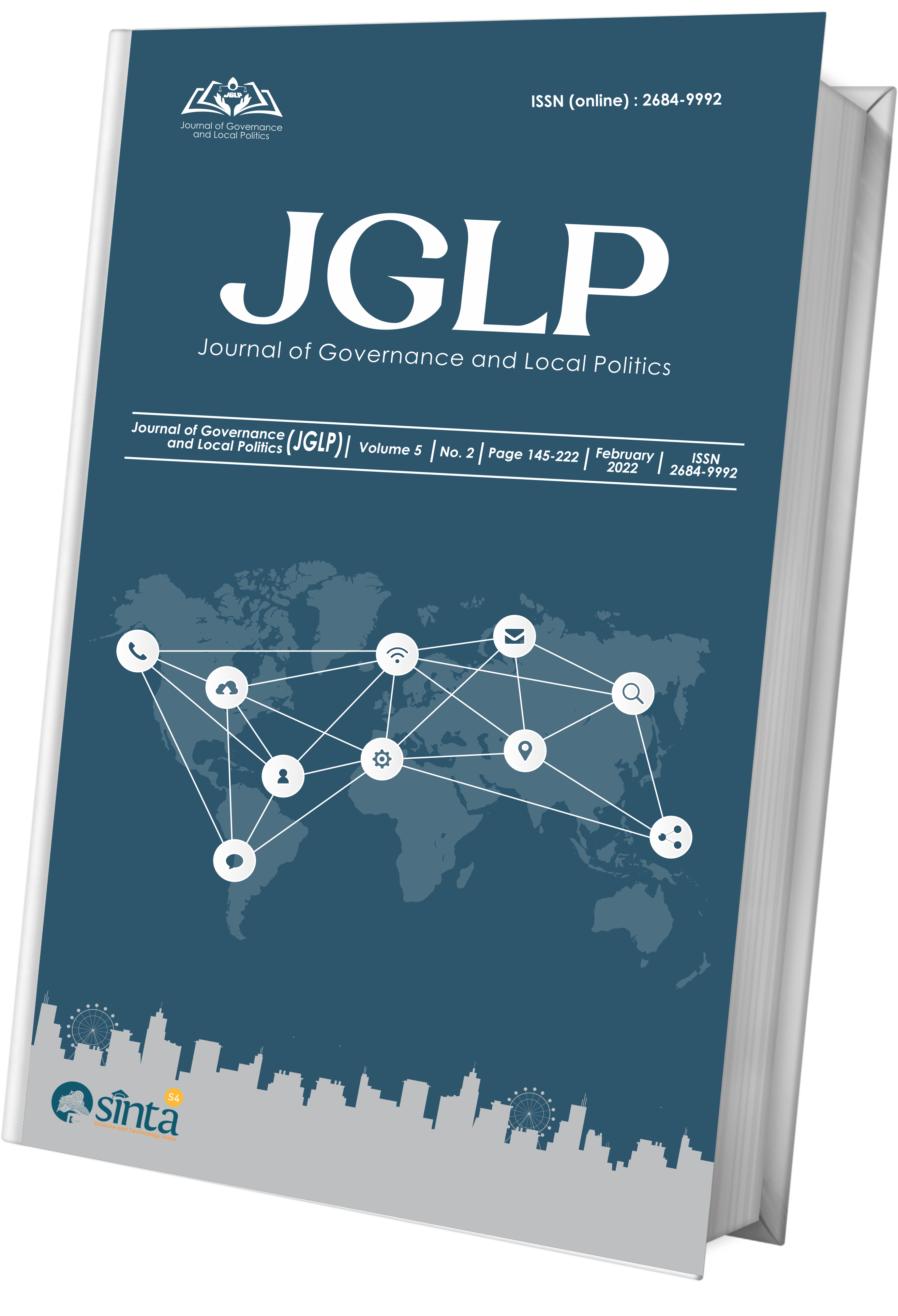Irrigation Management Strategy for Rice–Fish Farming as a Conflict Resolution between Farmers and Pond Owners in Kelingi Tugumulyo
Abstract
Management of Water Resources in irrigation areas is a vital aspect in supporting food security and community welfare. The Kelingi Tugumulyo Irrigation Area, located in Musi Rawas Regency and Lubuk Linggau City, is one of the important irrigation areas in South Sumatra. This area serves not only as a rice production center, but also as a location for the development of heavy-water pond fish farming. However, differences in interests between rice farmers and fish farmers often trigger water use conflicts. This study aims to identify the dynamics of water use conflicts, assess the role of local institutions, and formulate sustainable policy solutions. The method used is a descriptive qualitative approach with the support of quantitative data from BPS, BBWs Sumatra VIII, and field surveys. The results showed that the conflict was triggered by imbalances in water distribution, weak regulation, low compliance with water utilization permits, and institutional helplessness of farmers (P3A). The impact of the conflict is a decrease in rice harvest area, land conversion to non-rice sector, as well as socio-economic inequality among water user groups. This study recommends strengthening regulation, revitalization of P3A/GP3A institutions, integration of cropping patterns and fish farming, as well as the application of water-efficient irrigation technology.
References
Adi, M. I., Buyang, C. G., & Kalalimbong, A. (2022). Analisis Sistem Operasional Jaringan Irigasi Kobisadar Untuk Memenuhi Kebutuhan Lahan Pertanian Kabupaten Maluku Tengah. Journal Teknik Mesin Elektro Informatika Kelautan Dan Sains, 2(1), 44–50. https://doi.org/10.30598/metiks.2022.2.1.44-50
Alamanos, A., Koundouri, P., Papadaki, L., Pliakou, T., & Toli, E. (2022). Water for Tomorrow: A Living Lab on the Creation of the Science-Policy- StakeholdeInterface.Water (Switzerland), 14(18). https://doi.org/10.3390/w14182879
Ardiansah, I., Wargadibrata, R. B. N., Asdak, C., Rahmah, D. M., & Putri, S. H. (2018). Partisipasi Petani Terhadap Pengelolaan Air Irigasi Di Kecamatan Rancaekek, Kabupaten Bandung, Provinsi Jawa Barat. Jurnal Sains Dan Teknologi Industri, 16(1), 7. https://doi.org/10.24014/sitekin.v16i1.6274
Ashton, P. J. 2002. “Avoiding conflicts over Africa’s water resources,” Ambio, vol. 31, no. 3, pp. 236–242, 2002, doi: 10.1579/0044-7447-31.3.236.
Creswell, J. W. (2017). Research design: Qualitative, quantitative, and mixed methods approaches. Sage publications.
Firma Rizki, Doddy Aditya Iskandar, 2023, Consensus as the Local Spatial Strategy: Understanding Stakeholders Dynamics and Pattern of Water Utilization at Kelingi Tugumulyo Irrigation Area, ICOSEAT 2023, ABSR 26, pp. 237–244, 2023. https://doi.org/10.2991/978-94-6463-086-2_31
Gatti, K. Baylis, and B. Crost, “Can Irrigation Infrastructure Mitigate the Effect of Rainfall Shocks on Conflict? Evidence from Indonesia,” Am. J. Agric. Econ., vol. 103, no. 1, pp. 211–231, 2021, doi: 10.1002/ajae.12092.
Gebretsadik, K. A., & Romstad, E. (2020). Climate and farmers’ willingness to pay for improved irrigation water supply. World Development Perspectives, 20(June), 100233. https://doi.org/10.1016/j.wdp.2020.100233
Hamri, H., Amrullah, A., Amri, A., & Efendi, R. (2022). Analisis Irigasi Dengan Sistem Pipanisasi Untuk Persawahan. Jurnal Mekanova Mekanikal Inovasi Dan Teknologi, 8(1), 48. https://doi.org/10.35308/jmkn.v8i1.5263
Hardin, G. (1968). The tragedy of the commons: the population problem has no technical solution; it requires a fundamental extension in morality. Science, 162(3859), 1243–1248.
Jalaludin, R., & Laksmiati, D. (2023). Perancangan Sistem Kendali Irigasi Otomatis Dan Pengusir Hama Burung Dengan Menggunakan Sensor PIR. Jurnal Ilmiah Telsinas Elektro Sipil Dan Teknik Informasi, 6(2), 122–134. https://doi.org/10.38043/telsinas.v6i2.4565
Jiang, S, M., Xie, and S. Wang, “Water use conflict and coordination between agricultural and wetlands—a case study of Yanqi basin,” Water (Switzerland), vol. 12, no. 11, pp. 1–18, 2020, doi: 10.3390/w12113225.
Kampas, A. Petsakos, and S. Rozakis, “Price induced irrigation water saving : Unraveling conflicts and synergies between European agricultural and water policies for a Greek Water District,” Agric. Syst., vol. 113, pp. 28–38, 2012, doi: 10.1016/j.agsy.2012.07.003
Komarudin, R. (2010). Peningkatan Kinerja Jaringan Irigasi Melalui Penerapan Manajemen Yang Tepat Dan Konsisten Pada Daerah Irigasi Ciramajaya. Jurnal Teknik Sipil, 17(2), 115. https://doi.org/10.5614/jts.2010.17.2.4
Lake, T. C. M., Sayekti, R. W., & Soetopo, W. (2021). Studi Simulasi Pemberian Air Irigasi Berdasarkan Debit Andalan Di Daerah Irigasi Bena Kecamatan Amanuban Selatan Kabupaten Timor Tengah Selatan Provinsi Nusa Tenggara Timur. Jurnal Teknologi Dan Rekayasa Sumber Daya Air, 1(2), 839–849. https://doi.org/10.21776/ub.jtresda.2021.001.02.41
Mulyana, E. (2014). Keputusan Petani dalam Konversi Lahan Persawahan ke Lahan Non-Persawahan: Faktor dan Dampaknya.
Ostrom, E. (1990). Governing the commons: The evolution of institutions for collective action. Cambridge university press.
Prasetyo, W., Nisa’, F. K., & Herwindo, W. (2023). Penilaian Kinerja Saluran Irigasi Tersier Daerah Irigasi Rentang Kabupaten Indramayu Provinsi Jawa Barat Indonesia. Jurnal Inovasi Konstruksi, 2(2), 66–74. https://doi.org/10.56911/jik.v2i2.74
Rick J.Hogeboom. 2020.The Water Footprint Concept and Water’s Grand Environmental Challenges. One Earth 2: 218-222.
Rusmayadi, G., Indriyani, Sutrisno, E., Nugroho, R. J., Prasetyo, C., & Alaydrus, A. Z. A. (2023). Evaluasi Efisiensi Penggunaan Sumber Daya Air Dalam Irigasi Pertanian: Studi Kasus Di Wilayah Kabupaten Cianjur. 1(02), 112–118. https://doi.org/10.58812/jgws.v1i02.422
Saleh, E. (2010). Studi Konflik Air Irigasi dan Alternatif Penyelesaiannya di Daerah Irigasi Kelingi Sumatera Selatan. Jurnal Keteknikan Pertanian, 24(1).
Sayekti, R. W., Purwati, E., & Ismoyo, M. J. (2017). Simulasi Indeks Penggunaan Air (Ipa) Guna Penghematan Air Irigasi Di D.I. Sonosari Dan D.I. Pakis Kabupaten Malang. Jurnal Teknik Pengairan, 8(2), 241–251. https://doi.org/10.21776/ub.pengairan.2017.008.02.10
Schoderer, M. and M. Ott, “Contested water- and miningscapes – Explaining the high intensity of water and mining conflicts in a meta-study,” World Dev., vol. 154, p. 105888, 2022, doi: 10.1016/j.worlddev.2022.105888.
Setiadi, D., & Muhaemin, M. N. A. (2018). PENERAPAN INTERNET OF THINGS (IoT) PADA SISTEM MONITORING IRIGASI (SMART IRIGASI). Infotronik Jurnal Teknologi Informasi Dan Elektronika, 3(2), 95. https://doi.org/10.32897/infotronik.2018.3.2.108
Shahbaznezhadfard, M. 2022. “Development of a dynamics-based model for analyzing strategic water – environmental con fl icts : systems thinking instead of linear thinking,” vol. 24, no. 1, pp. 83–100, 2022, doi: 10.2166/wp.2021.145.
Sukmono, H., Sutikno, S., & Wardati, N. K. (2020). Prototipe Sistem Otomasi Gerbang Irigasi Dengan Implementasi Mikrokontroler Berbasis IoT. Jurnal Teknik Elektro Dan Komputasi (Elkom), 2(1), 30–40. https://doi.org/10.32528/elkom.v2i1.3133
Tohidin, T., Nanda, M. P., & Abdulgani, H. (2023). Memaksimalkan Potensi Air Melalui Optimalisasi Pola Tanam Dan Perawatan Infrastruktur Untuk Pertanian Yang Berkelanjutan. Jurnal Rekayasa Infrastruktur, 9(1), 69–80. https://doi.org/10.31943/jri.v9i1.224
Yendri, O., Putranto, D. D. A., & Sarino, S. (2019). Analisis Besaran Komponen Imbangan Air pada Lahan Irigasi Kelingi Tugumulyo Kabupaten Musi Rawas Provinsi Sumatera Selatan. Jurnal Civronlit Unbari, 4(2), 57–68.
Copyright (c) 2025 Journal of Governance and Local Politics (JGLP)

This work is licensed under a Creative Commons Attribution-NonCommercial-NoDerivatives 4.0 International License.










